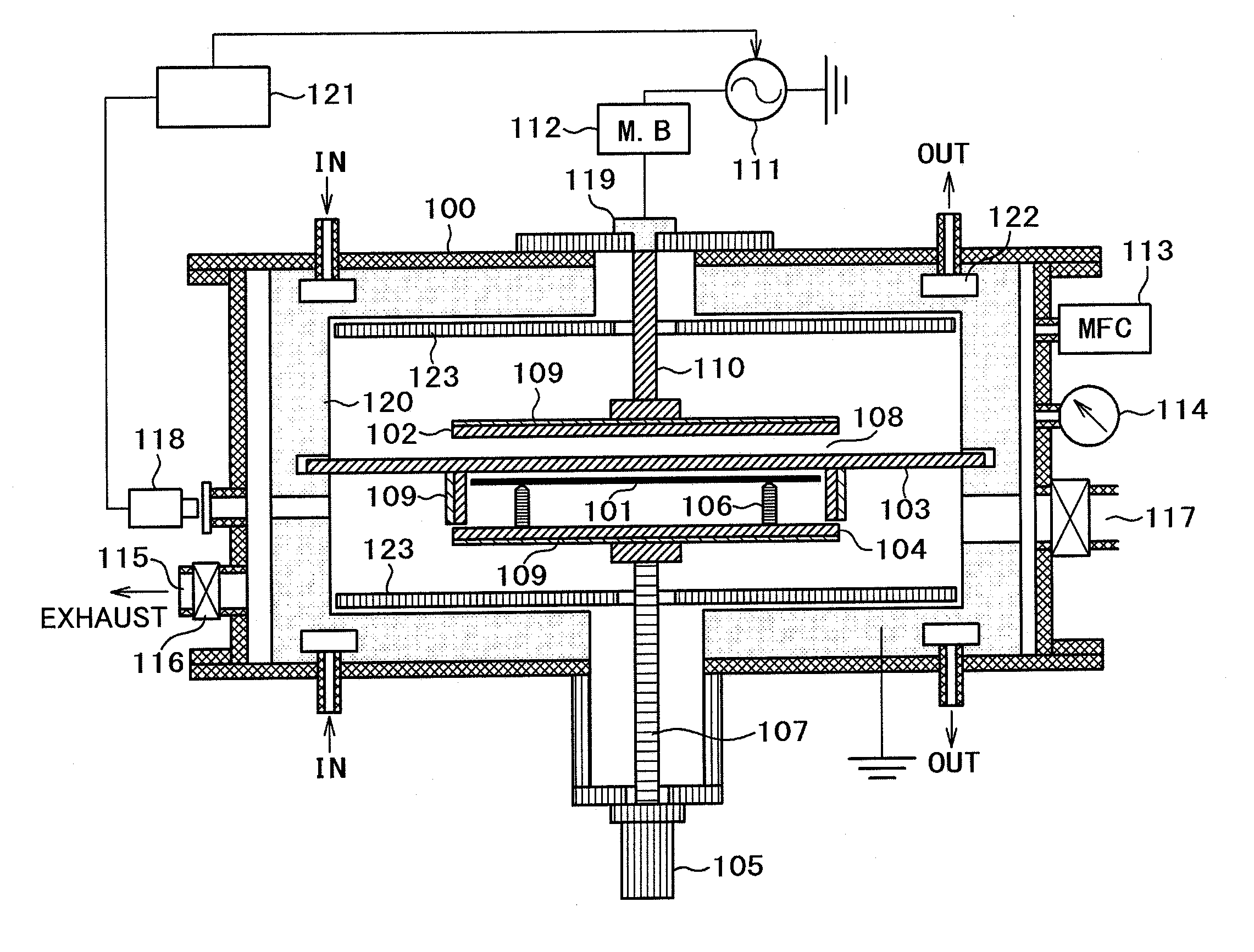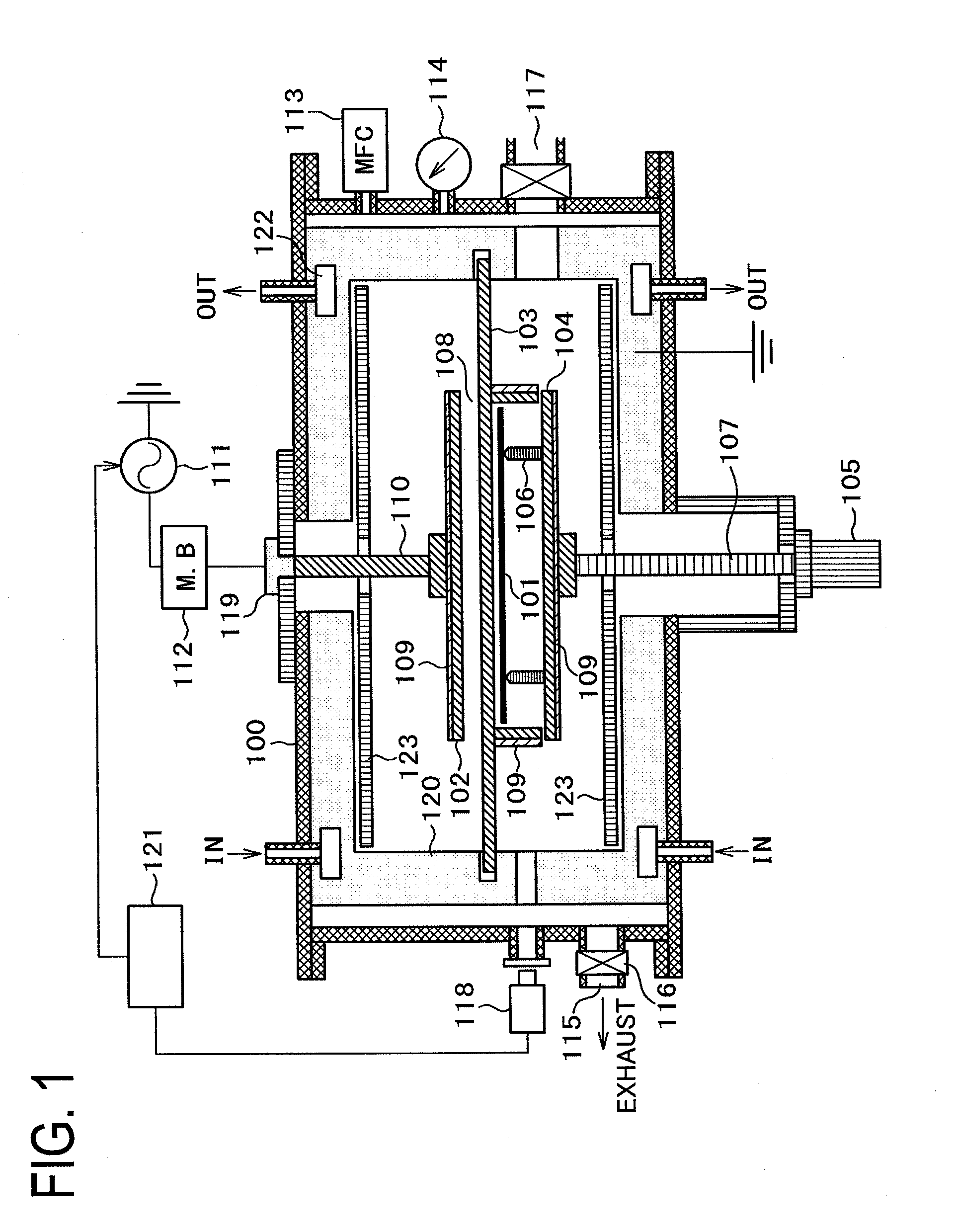Heat treatment apparatus
a technology of heat treatment apparatus and semiconductors, which is applied in the direction of welding apparatus, manufacturing tools, electric discharge tubes, etc., can solve the problems of extreme deterioration of thermal efficiency and energy efficiency required for heating, remarkable effects of thermal efficiency and high thermal efficiency
- Summary
- Abstract
- Description
- Claims
- Application Information
AI Technical Summary
Benefits of technology
Problems solved by technology
Method used
Image
Examples
first embodiment
[0033]A basic configuration in a heat treatment apparatus according to the present invention will be described with reference to FIG. 1.
[0034]The heat treatment apparatus of the embodiment includes a heating treatment chamber 100 that heats a specimen 101 to be heated by using plasma.
[0035]The heating treatment chamber 100 includes an upper electrode 102, a lower electrode 103 opposed to the upper electrode 102 and serving as a heating plate, a specimen stage 104 having a support pin 106 supporting the specimen 101 to be heated, a reflection mirror (a first radiant heat suppressing member) 120 reflecting radiant heat, a radio-frequency power supply 111 supplying radio-frequency power for generating plasma to the upper electrode 102, a gas introduction means 113 supplying gas into the heating treatment chamber 100, and a vacuum valve 116 adjusting pressure in the heating treatment chamber 100.
[0036]The specimen 101 to be heated is supported on the support pin 106 of the specimen stag...
second embodiment
[0094]FIG. 5 is a diagram illustrating a basic configuration in which the preliminary heating chamber 200 is additionally placed to the heat treatment apparatus of the first embodiment.
[0095]The same reference numerals as those of the first embodiment refer to components serving to perform the same functions. Therefore, a description thereof will be omitted.
[0096]In the heat treatment apparatus of the embodiment, the preliminary heating chamber 200 is connected to the lower part of the heating treatment chamber 100 through a gate valve 202. Each of the heating treatment chamber 100 and the preliminary heating chamber 200 is airtightly closed by closing the gate valve 202. The heating treatment chamber 100 and the preliminary heating chamber 200 are in communication with each other by opening the gate valve 202.
[0097]The heat of the preliminary heating chamber 200 is exhausted by a vacuum pump (not illustrated) connected to an exhaust port 203 and a vacuum valve 204.
[0098]The specime...
third embodiment
[0102]A basic configuration of a heat treatment apparatus according to a third embodiment will be described with reference to FIG. 6.
[0103]The heat treatment apparatus of the embodiment includes a heating treatment chamber 300 that heats a specimen 301 to be heated by using plasma.
[0104]The heating treatment chamber 300 includes an upper electrode 303 serving as the heating plate, which is mounted with the specimen 301 to be heated on the top thereof, a lower electrode 302 opposed to the upper electrode 303, a reflection mirror (a first radiant heat suppressing member) 308 reflecting radiant heat, a radio-frequency power supply 311 supplying radio-frequency power for generating plasma to the lower electrode 302, a gas introduction means 313 supplying gas into the heating treatment chamber 300, and a vacuum valve 316 adjusting pressure in the heating treatment chamber 300.
[0105]In the embodiment, as the specimen 301 to be heated, a 4 inch (φ100 mm) SiC substrate is used.
[0106]The dia...
PUM
| Property | Measurement | Unit |
|---|---|---|
| Thickness | aaaaa | aaaaa |
| Power | aaaaa | aaaaa |
| Melting point | aaaaa | aaaaa |
Abstract
Description
Claims
Application Information
 Login to View More
Login to View More - R&D
- Intellectual Property
- Life Sciences
- Materials
- Tech Scout
- Unparalleled Data Quality
- Higher Quality Content
- 60% Fewer Hallucinations
Browse by: Latest US Patents, China's latest patents, Technical Efficacy Thesaurus, Application Domain, Technology Topic, Popular Technical Reports.
© 2025 PatSnap. All rights reserved.Legal|Privacy policy|Modern Slavery Act Transparency Statement|Sitemap|About US| Contact US: help@patsnap.com



